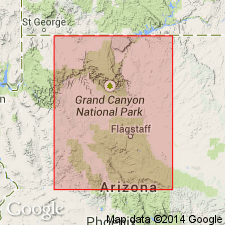
- Usage in publication:
-
- Parashant tongue
- Modifications:
-
- Original reference
- Dominant lithology:
-
- Dolomite
- AAPG geologic province:
-
- Plateau sedimentary province
Summary:
"It is confusing, from McKee's text and fig. 1 whether the tongue is assigned to the Muav formation or to the Bright Angel shale" (GNC note, n.d.). Parashant tongue [of Muav formation of Tonto group] (USGS Bull. 1200); Parashant tongue [of Bright Angel shale of Tonto group] (USGS DDS-6).
Pg. 14 (fig. 1), 29, 98-99. Consists chiefly of fine- and uniform-grained dolomite which appears steely gray on fresh surfaces and weathers rusty brown. Usually contains much glauconitic and ferruginous material both as disseminated grains and in lenses. Strongly cross-laminated at Toroweap. Average thickness about 10 feet. Older than Boucher tongue (new); younger than Lava Falls tongue (new). Represents a time of sea transgression. [On p. 29 age stated to be Early and Middle Cambrian and on p. 184 (part 2) Middle Cambrian. Age is considered Early and(or) Middle Cambrian.] Report includes cross section, measured section.
A thin but persistent and conspicuous unit in Cambrian sequence of Grand Canyon, extending from vicinity of Granite Park eastward at least as far as Toroweap, [Coconino Co., northwestern AZ].
Source: US geologic names lexicon (USGS Bull. 1200, p. 2924); supplemental information from GNU records (USGS DDS-6; Menlo GNULEX, Denver GNULEX), GNC index card files.
For more information, please contact Nancy Stamm, Geologic Names Committee Secretary.
Asterisk (*) indicates published by U.S. Geological Survey authors.
"No current usage" (†) implies that a name has been abandoned or has fallen into disuse. Former usage and, if known, replacement name given in parentheses ( ).
Slash (/) indicates name conflicts with nomenclatural guidelines (CSN, 1933; ACSN, 1961, 1970; NACSN, 1983, 2005, 2021). May be explained within brackets ([ ]).

